June 2021
June 25, 2021
Death by golf and peacocks
Oct 1951: Edward Harrison died in a freak golf accident, by managing to stab himself in the leg with a broken club. As he lay bleeding to death, he screamed for help. "Two other golfers said they twice heard screams, but thought they were the cries of peacocks from a peacock farm."
Deseret News - Oct 9, 1951
Posted By: Alex - Fri Jun 25, 2021 -
Comments (2)
Category: Death, Sports, Golf, 1950s
Follies of the Madmen #510
What's the point of using even a drawing of a pretty woman in your ad if you hide her face?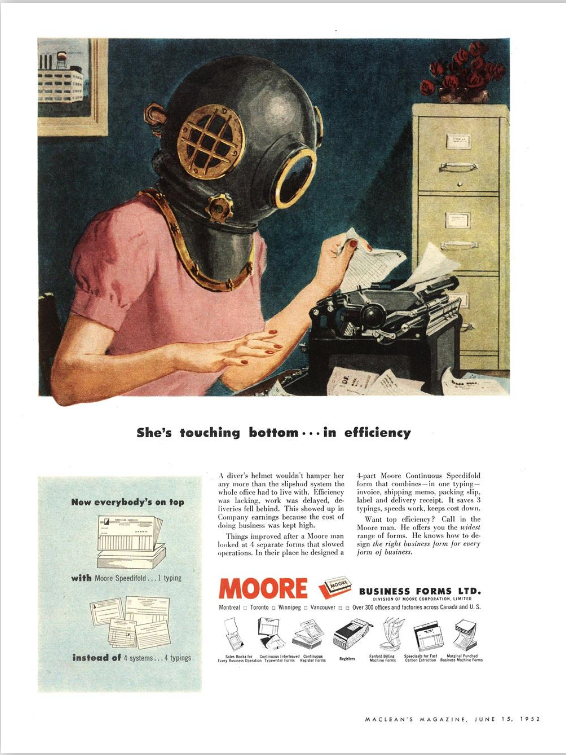
Source.
Posted By: Paul - Fri Jun 25, 2021 -
Comments (3)
Category: Business, Advertising, Sex Symbols, 1950s
June 24, 2021
Hiccup-curing straw (and other hiccup cures)
Researchers have invented a straw that, they claim, will cure hiccups. They call it the HiccAway. From the product page:
Back in 2015, we posted about Hiccupops, invented by 16-year-old Mallory Kievman. These were apple-cider lollipops that, she said, could cure hiccups. Apparently she's done well with her invention, because she's now the CEO of a company selling them.
And here's some more hiccup cures, from an article I wrote for about.com (back when the site still existed):
But in the second half of the 20th century, researchers stumbled upon some less-invasive, but definitely odd, hiccup cures.
The first of these was reported by Dr. Erminio Cardi of Rhode Island in an August 1961 issue of the New England Journal of Medicine. Dr. Cardi had discovered that he was able to cure the hiccups of several patients simply by using a cotton swab to manipulate a hair in their external ear canal. He confessed that this treatment was "seemingly unorthodox," but it worked. He theorized that it did so because the hair had been irritating a nerve that triggered the hiccup response.
And if examination of the ear revealed no hair irritant? No problem. In that case "twirl a stick tipped with cocaine-soaked cotton in the ear," instructed the doctor.
Nowadays doctors are more likely to use lidocaine than cocaine, but the principle remains the same.
The second cure is even more unorthodox, but again, it seems to work. In an August 1988 issue of the Annals of Emergency Medicine, Dr. Francis Fesmire of Jacksonville, Florida reported that a "digital rectal massage" (aka a finger up the bum) had unexpectedly cured a patient of hiccups. Fesmire didn't record what inspired him to think of this technique, but the reason why it worked, he suggested, was similar to the ear method — because it calmed an overactive nerve. Several other doctors have subsequently reported success using this technique.
Posted By: Alex - Thu Jun 24, 2021 -
Comments (4)
Category: Health
Polyform, Edison’s Topical Anesthetic
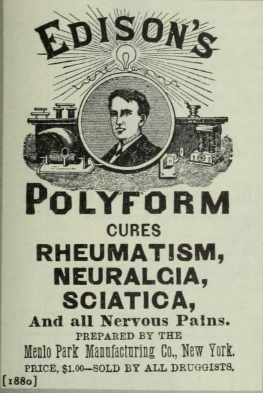
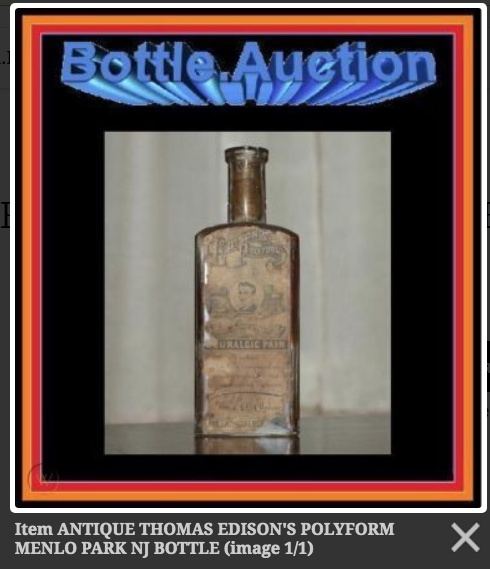
American inventor and businessman Thomas Alva Edison is legendary for his contributions to such technologies as the lightbulb, the telephone, the phonograph, and motion pictures, among many others.1In his lifetime, Edison obtained 1,093 US patents and some 1,239 patents in other countries. Little known among these efforts was his “improved anesthetic compound.”
In the summer of 1882, George F. Shrady (Founder and Editor, Medical Record 1866–1904) (1837–1907), reported that Thomas Edison invented a new anesthetic made of chloroform, ether, alcohol, and camphor and had applied for British and German patents.2The witty but misinformed editor added, “Edison may wish to use it on his stockholders until electric light was in successful operation.”
In fact, the “anesthetic” actually was an analgesic liniment that Edison had prepared in early 1878. He named it Polyform and advertised it for “neurologic pain.” Polyform was a mixture of chloroform, ether, camphor gum, alcohol, chloral hydrate, morphine, and oils of peppermint and clove. Edison believed that his compound’s various analgesics would potentiate each other and that the mixture would attack pain in a “shotgun manner.”3
More info here.
Posted By: Paul - Thu Jun 24, 2021 -
Comments (1)
Category: Celebrities, Inventions, Patent Medicines, Nostrums and Snake Oil, Nineteenth Century
June 23, 2021
Death by playing cards
Oct 20, 1930: Convict William Kogut, who was waiting execution on San Quentin's death row, somehow knew that it was possible to make a bomb out of playing cards. This was because, at the time, the red ink of cards contained nitrocellulose. So by scraping off enough of the red ink, Kogut was able to make a pipe bomb out of a hollow bedpost. He used this to kill himself, rather than letting himself be executed.Modern playing cards no longer contain this explosive ingredient.
Somewhat confusingly, Snopes classifies his death as a "legend," even though their brief write-up seems to confirm that it happened exactly as described.
More info: theatrefx.com
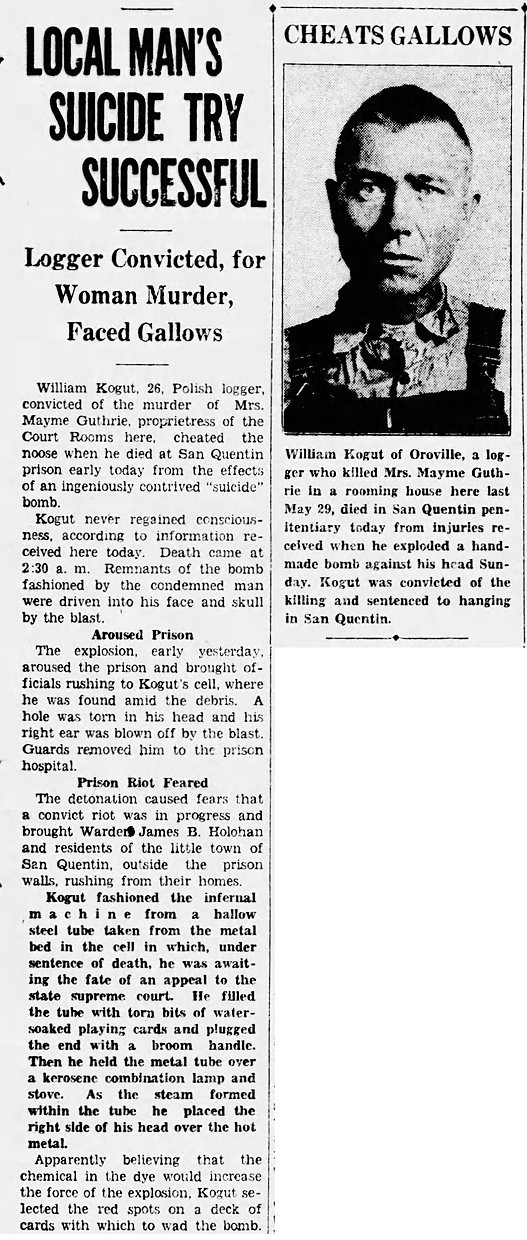
Oroville Mercury Register - Oct 20, 1930
Posted By: Alex - Wed Jun 23, 2021 -
Comments (3)
Category: Death, Suicide, Prisons, 1930s
1967 Hippie Festival
Eighteen minutes of unscripted grooviness. I am particularly taken by two beautiful women performing some kind of mutual meditation exercise, as seen in the still shot below.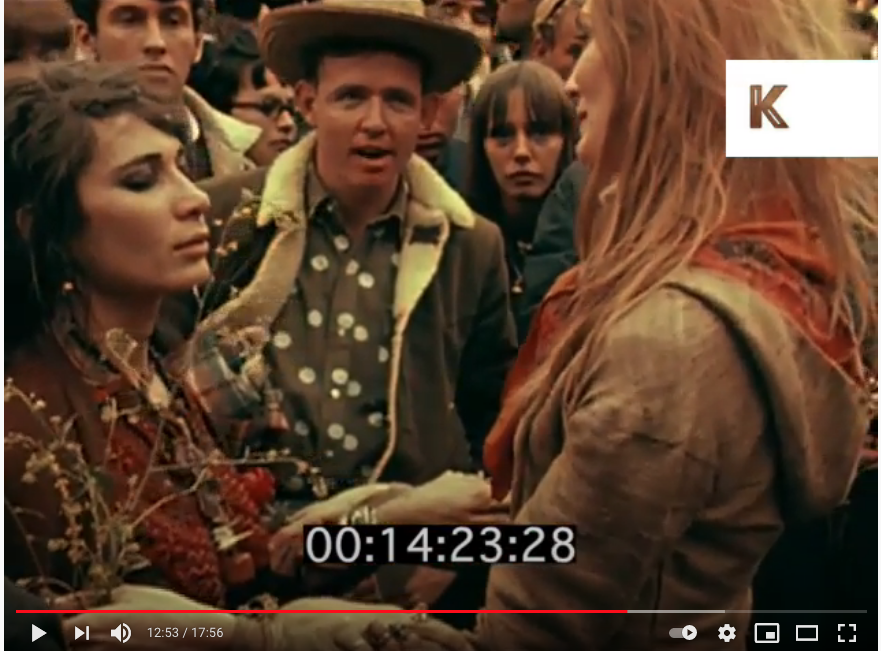
Posted By: Paul - Wed Jun 23, 2021 -
Comments (2)
Category: Parades and Festivals, Bohemians, Beatniks, Hippies and Slackers, 1960s
June 22, 2021
Horse Spike
In 1899, Patent No. 636,430 was granted to Franz and Konrad Hieke of Philadelphia for what they described as "cavalry equipment". It was essentially a large spike attached to the front of a horse. From their patent:
A better view:

Argos Reflector - Feb 8, 1900
I wonder if one of these was ever actually used in combat?
Posted By: Alex - Tue Jun 22, 2021 -
Comments (3)
Category: Animals, Inventions, Patents, Weapons, Nineteenth Century
Maid of Cotton
Unique in mandating the composition of all contest garments: 100% cotton, what else!Full story here.
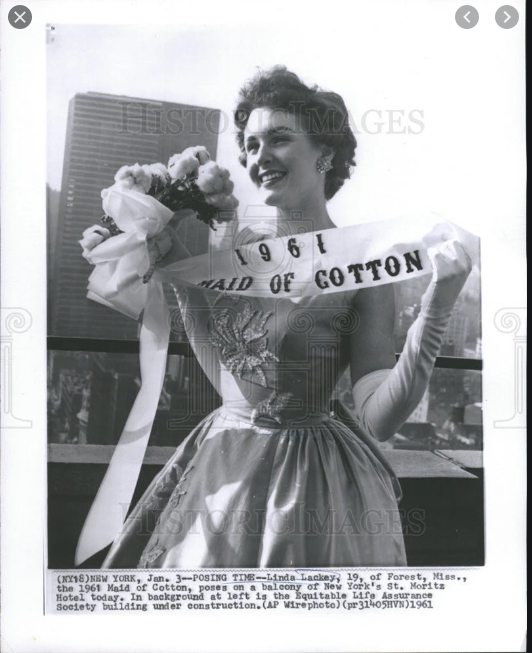
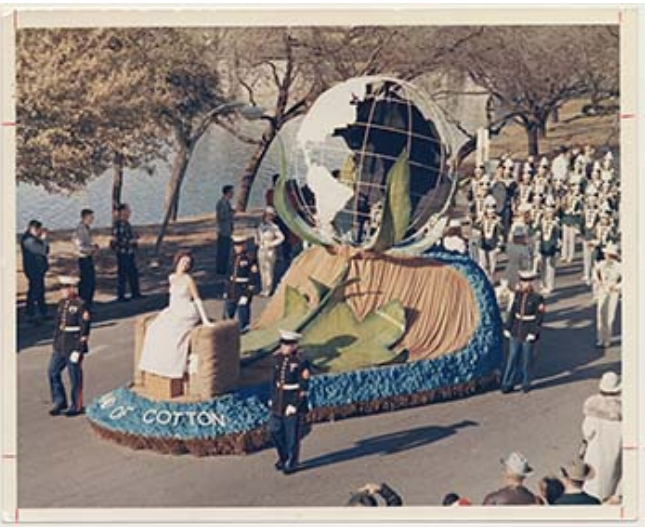
Posted By: Paul - Tue Jun 22, 2021 -
Comments (3)
Category: Agriculture, Awards, Prizes, Competitions and Contests, Beauty, Ugliness and Other Aesthetic Issues, Regionalism, 1930s
June 21, 2021
Earl Grey Tea Intoxication
As reported in the April 17, 2002 issue of The Lancet:After 3 weeks, they also occurred in the left foot. After 5 weeks, muscle cramps had spread towards the hands and the right calf. Occasionally, he observed fasciculations of the right adductor pollicis and gastrocnemius. Additionally, he noted distal paraesthesias in all limbs, and a feeling of pressure in his eyes, associated with blurred vision, particularly in darkness...
The patient assumed that there was a relation between his symptoms and his tea consumption, and stopped drinking Earl Grey after 5 months, reverting to pure black tea again. Within 1 week, his symptoms had completely disappeared. Symptoms also remained absent if he completely withdrew from tea, which he did in the nature of experiment, for about a week. He found that his symptoms did not recur as long as he consumed no more than 1 L of Earl Grey daily.
When last seen in November, 2001, neurological examination, nerve conduction studies, and electromyography were normal. He was still drinking 2 L of plain black tea daily (his entire fluid intake), and had no complaints.
The moral of his story is that 2 liters of tea a day is apparently fine. But 4 liters is asking for trouble.

via reddit
Posted By: Alex - Mon Jun 21, 2021 -
Comments (3)
Category: Inebriation and Intoxicants, Coffee and other Legal Stimulants
Yoko Ono, “Cut Piece”
To accompany Alex's Patty Chang post from yesterday.
Posted By: Paul - Mon Jun 21, 2021 -
Comments (0)
Category: Fashion, Performance Art, 1960s
| Get WU Posts by Email | |
|---|---|

| Who We Are |
|---|
| Alex Boese Alex is the creator and curator of the Museum of Hoaxes. He's also the author of various weird, non-fiction books such as Elephants on Acid. Paul Di Filippo Paul has been paid to put weird ideas into fictional form for over thirty years, in his career as a noted science fiction writer. He has recently begun blogging on many curious topics with three fellow writers at The Inferior 4+1. Chuck Shepherd Chuck is the purveyor of News of the Weird, the syndicated column which for decades has set the gold-standard for reporting on oddities and the bizarre. Our banner was drawn by the legendary underground cartoonist Rick Altergott. Contact Us |

